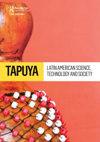地貌的变化、威胁以及上特隆贝塔斯前逃亡黑奴社区为争夺领地而进行的斗争
IF 1.2
Q2 HISTORY & PHILOSOPHY OF SCIENCE
Tapuya: Latin American Science, Technology and Society
Pub Date : 2023-12-11
DOI:10.1080/25729861.2023.2278866
引用次数: 0
摘要
摘要 本研究探讨了特隆贝塔斯河畔上特隆贝塔斯 1 号和 2 号社区的前逃亡黑奴领地的景观变化。研究还指出了自联邦保护单位建立和铝土矿开采活动在该地区开展以来所发生的变化。重叠的产生和管理涉及到一个由国家行为者、人工制品和社会技术设备组成的异质网络,在一个由政府机构、规范和有利于进步和利润的言论组成的网络中,对景观进行具体的干预。这种重叠使得社区组织起来反对对其土地的入侵,并不断努力使采矿和保护单位的影响得到关注。我们的结论是,国家不同部门历史上有问题的干预损害了前逃亡黑奴领地与该地区其他生命的共存。此外,缺乏针对采矿对前逃亡黑奴社区影响的监测和研究也表明了环境种族主义是如何侵害种族化的身体和领土的。然而,前逃亡黑奴社区继续在其祖先的领地上进行抵抗。本文章由计算机程序翻译,如有差异,请以英文原文为准。
Changes in the landscape, threats, and the struggle of the quilombola communities from Alto Trombetas for their territories
ABSTRACT This study addresses landscape changes in the quilombola territories of the communities Alto Trombetas 1 and 2, on the banks of the Trombetas River. It also points out transformations that have taken place since the creation of federal conservation units and the installation of bauxite mining activities in the region. The production and management of overlaps involves a heterogeneous network of state actors, artifacts, and socio-technical apparatuses that materialize interventions in the landscape, in a web of government bodies, norms, and a discourse favorable to progress and profit. This overlap has made the communities organize themselves against the invasion of their lands and struggle constantly to give visibility to the effects of mining and conservation units. We conclude that the history of questionable interventions from different sectors of the state has compromised the coexistence of quilombola territories with other lives in the region. Also, the lack of monitoring and studies focused on the effects of mining on quilombola communities shows how environmental racism falls upon racialized bodies and territories. However, quilombola communities continue to resist in their ancestral territories.
求助全文
通过发布文献求助,成功后即可免费获取论文全文。
去求助
来源期刊

Tapuya: Latin American Science, Technology and Society
Social Sciences-Social Sciences (all)
CiteScore
1.60
自引率
0.00%
发文量
39
审稿时长
19 weeks
 求助内容:
求助内容: 应助结果提醒方式:
应助结果提醒方式:


